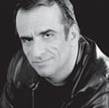 Louis-Jacques Mandé Daguerre (1787-1851) was a French artist from whose name was coined the expression "daguerreotype." The daguerreotype supposedly was the first 'photographic' technique to be invented. In 1837 Daguerre developed a light sensitive copper plate, the "mirror with a memory," making a public announcement of his invention in Paris during the summer of 1839.
Louis-Jacques Mandé Daguerre (1787-1851) was a French artist from whose name was coined the expression "daguerreotype." The daguerreotype supposedly was the first 'photographic' technique to be invented. In 1837 Daguerre developed a light sensitive copper plate, the "mirror with a memory," making a public announcement of his invention in Paris during the summer of 1839.
William Fox Talbot, an English amateur scientist, developed another pioneering technique at the same time as Daguerre: the calotype. The calotype is a negative/positive photographic process, closer to today's techniques than the daguerreotype, using paper in the negative and positive phases. The positive is developed through contact exposure with the negative under sunlight.
Absolute proof of precedence may never be determined since Daguerre and Talbot publicized their distinct and pioneering methods at about the same time.
Both techniques rest on two fundamental principles of chemistry and physics: (i) the reaction of some chemicals to light exposure, and (ii) the formation of images when light passes through an aperture in a dark room or box. The daguerreotype's emulsion-equivalent is made by salts of silver and iodine developed through exposure to mercury fumes.
The daguerreotype is a physical container of copied visual information, having the properties of a two-dimensional image and a three-dimensional object. It neither looks nor feels like a photograph, displaying itself in both a medium and a way quite different from modern photographs.
Its image rests on a highly polished copper plate, with its brilliant mirror-like silver surface providing great visual depth that makes viewing difficult. A daguerreotype must be viewed from a specific angle or its image will appear as a negative totally reversed.
The daguerreotype image is unique, since there is no negative to copy from or from which to make other copies. Its greatest technical advantage is the incredible detail it provides (much better than the calotype).
Its shinning surface is physically luxurious, and it can beautify an ordinary subject. As the image seems to rise from the copper plate surface, the daguerreotype can give a sense of 3D. The daguerreotype suggests a sense of magical realism.
The daguerreotype's mirrored surface seems to include the viewer in its image. One can adjust the viewing distance in order that the viewers' face and the photographic subject synchronize. As the eyes of viewer and subject overlap, one can experience a sense of traveling in time and space.
The daguerreotype's delicate surface is protected in a small closed case making the viewing experience intimate and private. The daguerreotype is designed to be seeing in one's hand and not on a wall. It can create a sense of tension as it flickers between the positive and the negative surface image.
"Daguerreotypemania" conquered Europe and the United States in mid 19th century. At that point in time the daguerreotype was the main photographic method available around the world. But it was Talbot's calotype, with the advantage of allowing for endless paper reproduction from negatives and better equipment-portability, which led to "wet plate" techniques that dominated the photographic world of the 1850's through the 1870's. Starting in the 1870's, "dry plates" or roll films became the direct line ancestors of modern photographic techniques.
Daguerreotypes are still produced by purists who keep alive this old tradition. Original daguerreotypes are part of museum collections like the George Eastman House in Rochester, New York and the Bibliothèque National in Paris, France.
The first pictures seen in Brazil appeared during the Second Empire. Many traveling photographers documented the landed elite and their families with their cameras. Those photographic documentaries were done in the Daguerre technique and, in time, became an important medium.
These documentaries recorded and diffused a Brazilian culture heavily influenced by Portugal and the rest of Europe. Among the most notable photographers who embraced the French "Daguerre" technique were Inslei Pacheco, Stahl and Wahnschaffe.



